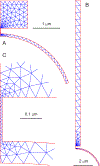Analysis of potassium ion diffusion from neurons to capillaries: Effects of astrocyte endfeet geometry
- PMID: 38123136
- PMCID: PMC10872621
- DOI: 10.1111/ejn.16232
Analysis of potassium ion diffusion from neurons to capillaries: Effects of astrocyte endfeet geometry
Abstract
Neurovascular coupling (NVC) refers to a local increase in cerebral blood flow in response to increased neuronal activity. Mechanisms of communication between neurons and blood vessels remain unclear. Astrocyte endfeet almost completely cover cerebral capillaries, suggesting that astrocytes play a role in NVC by releasing vasoactive substances near capillaries. An alternative hypothesis is that direct diffusion through the extracellular space of potassium ions (K+ ) released by neurons contributes to NVC. Here, the goal is to determine whether astrocyte endfeet present a barrier to K+ diffusion from neurons to capillaries. Two simplified 2D geometries of extracellular space, clefts between endfeet, and perivascular space are used: (i) a source 1 μm from a capillary; (ii) a neuron 15 μm from a capillary. K+ release is modelled as a step increase in [K+ ] at the outer boundary of the extracellular space. The time-dependent diffusion equation is solved numerically. In the first geometry, perivascular [K+ ] approaches its final value within 0.05 s. Decreasing endfeet cleft width or increasing perivascular space width slows the rise in [K+ ]. In the second geometry, the increase in perivascular [K+ ] occurs within 0.5 s and is insensitive to changes in cleft width or perivascular space width. Predicted levels of perivascular [K+ ] are sufficient to cause vasodilation, and the rise time is within the time for flow increase in NVC. These results suggest that direct diffusion of K+ through the extracellular space is a possible NVC signalling mechanism.
Keywords: astrocyte endfeet; diffusion; extracellular space; neurovascular coupling; potassium ions.
© 2023 Federation of European Neuroscience Societies and John Wiley & Sons Ltd.
Figures






References
-
- Ambrosi G, Virgintino D, Benagiano V, Maiorano E, Bertossi M, & Roncali L (1995). Glial cells and blood-brain barrier in the human cerebral cortex. Italian Journal of Anatomy and Embryology = Archivio Italiano Di Anatomia Ed Embriologia, 100 Suppl 1, 177–184. http://europepmc.org/abstract/MED/11322290 - PubMed
-
- Berne RM, Rubio R, & Curnish RR (1974). Release of Adenosine from Ischemic Brain. Circulation Research, 35, 262–271. 10.1161/01.RES.35.2.262 - DOI
-
- Castejón OJ (1988). Ultrastructural alterations of human cortical capillary basement membrane in perifocal brain edema. Journal of Submicroscopic Cytology and Pathology, 20, 519–536. http://europepmc.org/abstract/MED/3179992 - PubMed
MeSH terms
Substances
Grants and funding
LinkOut - more resources
Full Text Sources

